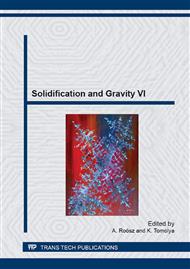p.73
p.79
p.85
p.91
p.97
p.103
p.109
p.115
p.121
Trapping Effect on the Kinetic Critical Radius in Nucleation and Growth Processes
Abstract:
The critical nucleus size—above which nuclei grow, below dissolve—during diffusion controlled nucleation in binary solid-solid phase transformation process is calculated using kinetic Monte Carlo (KMC). If atomic jumps are slower in an A-rich nucleus than in the embedding B-rich matrix, the nucleus traps the A atoms approaching its surface. It doesn’t have enough time to eject A atoms before new ones arrive, even if it would be favourable thermodynamically. In this case the critical nucleus size can be even by an order of magnitude smaller than expected from equilibrium thermodynamics or without trapping. These results were published in [Z. Erdélyi et al., Acta Mater. 58 (2010) 5639]. In a recent paper M. Leitner [M. Leitner, Acta Mater. 60 (2012) 6709] has questioned our results based on the arguments that his simulations led to different results, but he could not point out the reason for the difference. In this paper we summarize our original results and on the basis of recent KMC and kinetic mean field (KMF) simulations we show that Leitner’s conclusions are not valid and we confirm again our original results.
Info:
Periodical:
Pages:
97-102
Citation:
Online since:
May 2014
Authors:
Price:
Сopyright:
© 2014 Trans Tech Publications Ltd. All Rights Reserved
Share:
Citation:


